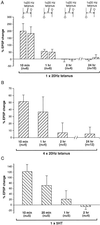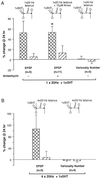A novel function for serotonin-mediated short-term facilitation in aplysia: conversion of a transient, cell-wide homosynaptic hebbian plasticity into a persistent, protein synthesis-independent synapse-specific enhancement
- PMID: 11027355
- PMCID: PMC17243
- DOI: 10.1073/pnas.97.21.11581
A novel function for serotonin-mediated short-term facilitation in aplysia: conversion of a transient, cell-wide homosynaptic hebbian plasticity into a persistent, protein synthesis-independent synapse-specific enhancement
Abstract
Studies of sensitization and classical conditioning of the gill-withdrawal reflex in Aplysia have shown that the synaptic connections between identified glutamatergic sensory neurons and motor neurons can be enhanced in one of two ways: by a heterosynaptic (modulatory input-dependent) mechanism that gives rise with repetition to long-term facilitation and by a homosynaptic (activity-dependent) mechanism that gives rise with repetition to a facilitation that is partially blocked by 2-amino-5-phosphonovaleric acid and by injection of 1,2-bis(2-aminophenoxy)ethane-N,N,N', N'-tetraacetate (BAPTA) into the postsynaptic cell and is similar to long-term potentiation in the hippocampus. We here have examined how these two forms of facilitation interact at the level of an individual synaptic connection by using a culture preparation consisting of a single bifurcated sensory neuron that forms independent synaptic contacts with each of two spatially separated motor neurons. We find that the homosynaptic facilitation produced by a train of action potentials is cell wide and is evident at all of the terminals of the sensory neuron. By contrast, the heterosynaptic facilitation mediated by the modulatory transmitter serotonin (5-HT) can operate at the level of a single synapse. Homosynaptic activation gives rise to only a transient facilitation lasting a few hours, even when repeated in a spaced manner. The heterosynaptic facilitation produced by a single pulse of 5-HT, applied to one terminal of the sensory neuron, also lasts only minutes. However, when one or more homosynaptic trains of spike activity are paired with even a single pulse of 5-HT applied to one of the two branches of the sensory neuron, the combined actions lead to a selective enhancement in synaptic strength only at the 5-HT-treated branch that now lasts more than a day, and thus amplifies, by more than 20-fold, the duration of the individually produced homo- and heterosynaptic facilitation. This form of synapse-specific facilitation has unusual long-term properties. It does not require protein synthesis, nor is it accompanied by synaptic growth.
Figures



References
-
- Kandel E R. Cellular Basis of Behavior: An Introduction to Behavioral Biology. San Francisco: Freeman; 1976.
-
- Carew T J, Sahley C L. Annu Rev Neurosci. 1986;9:435–487. - PubMed
-
- Byrne J H. Physiol Rev. 1987;67:329–439. - PubMed
-
- Hawkins R D, Kandel E R, Siegelbaum S A. Annu Rev Neurosci. 1993;16:625–665. - PubMed
-
- Pinsker H M, Hening W A, Carew T J, Kandel E R. Science. 1973;182:1039–1042. - PubMed
Publication types
MeSH terms
Substances
Grants and funding
LinkOut - more resources
Full Text Sources
Miscellaneous

